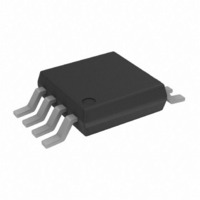AD8220ARMZ Analog Devices Inc, AD8220ARMZ Datasheet - Page 20

AD8220ARMZ
Manufacturer Part Number
AD8220ARMZ
Description
IC AMP INST JFET R-R 15MA 8MSOP
Manufacturer
Analog Devices Inc
Type
Instrumentation Ampr
Datasheet
1.AD8220-EVALZ.pdf
(28 pages)
Specifications of AD8220ARMZ
Design Resources
Fully Isolated Input Module Based on AD7793, ADuM5401, and a High Performance In-Amp (CN0067)
Amplifier Type
Instrumentation
Number Of Circuits
1
Output Type
Rail-to-Rail
Slew Rate
2 V/µs
-3db Bandwidth
1.5MHz
Current - Input Bias
25pA
Voltage - Input Offset
250µV
Current - Supply
750µA
Current - Output / Channel
15mA
Voltage - Supply, Single/dual (±)
4.5 V ~ 36 V, ±2.25 V ~ 18 V
Operating Temperature
-40°C ~ 85°C
Mounting Type
Surface Mount
Package / Case
8-MSOP, Micro8™, 8-uMAX, 8-uSOP,
Number Of Channels
1
Number Of Elements
1
Power Supply Requirement
Single/Dual
Common Mode Rejection Ratio
74dB
Voltage Gain Db
60dB
Input Offset Voltage
0.3@±5VmV
Input Bias Current
0.000025@5VnA
Single Supply Voltage (typ)
5/9/12/15/18/24/28V
Rail/rail I/o Type
Rail to Rail Output
Single Supply Voltage (min)
4.5V
Single Supply Voltage (max)
36V
Dual Supply Voltage (min)
±2.25V
Dual Supply Voltage (max)
±18V
Operating Temp Range
-40C to 85C
Operating Temperature Classification
Industrial
Mounting
Surface Mount
Pin Count
8
Package Type
MSOP
No. Of Amplifiers
1
Bandwidth
1.5MHz
Amplifier Output
Differential
Cmrr
84dB
Supply Voltage Range
± 2.25V To ± 18V
Supply Current
750µA
Rohs Compliant
Yes
Gain Db Min
1dB
Lead Free Status / RoHS Status
Lead free / RoHS Compliant
For Use With
AD8220-EVALZ - BOARD EVAL FOR AD8220ARMZ
Gain Bandwidth Product
-
Lead Free Status / RoHS Status
Compliant, Lead free / RoHS Compliant
Available stocks
Company
Part Number
Manufacturer
Quantity
Price
Part Number:
AD8220ARMZ
Manufacturer:
ADI/亚德诺
Quantity:
20 000
Part Number:
AD8220ARMZ-R7
Manufacturer:
ADI原装
Quantity:
20 000
Part Number:
AD8220ARMZ-REEL7
Manufacturer:
ADI/亚德诺
Quantity:
20 000
AD8220
GAIN SELECTION
Placing a resistor across the R
which can be calculated by referring to Table 5 or by using the
gain equation
Table 5. Gains Achieved Using 1% Resistors
1% Standard Table Value of RG (Ω)
49.9 k
12.4 k
5.49 k
2.61 k
1.00 k
499
249
100
49.9
The AD8220 defaults to G = 1 when no gain resistor is used.
Gain accuracy is determined by the absolute tolerance of R
The TC of the external gain resistor increases the gain drift of
the instrumentation amplifier. Gain error and gain drift are kept
to a minimum when the gain resistor is not used.
LAYOUT
Careful board layout maximizes system performance. In
applications that need to take advantage of the low input bias
current of the AD8220, avoid placing metal under the input path
to minimize leakage current. To maintain high CMRR over
frequency, lay out the input traces symmetrically and lay out the
traces of the R
maintain resistive and capacitive balance; this holds for additional
PCB metal layers under the input and R
Figure 57. Example Layout—Top Layer of the AD8220 Evaluation Board
R
G
49
G
4 .
G
kΩ
resistor symmetrically. Ensure that the traces
1
G
terminals sets the AD8220 gain,
G
pins. Traces from the
Calculated Gain
1.990
4.984
9.998
19.93
50.40
100.0
199.4
495.0
991.0
G
.
Rev. B | Page 20 of 28
gain setting resistor to the R
possible to minimize parasitic inductance. An example layout is
shown in Figure 57 and Figure 58. To ensure the most accurate
output, the trace from the REF pin should either be connected to
the AD8220 local ground (see Figure 59) or connected to a
voltage that is referenced to the AD8220 local ground.
Common-Mode Rejection Ratio (CMRR)
The AD8220 has high CMRR over frequency giving it greater
immunity to disturbances, such as line noise and its associated
harmonics, in contrast to typical in-amps whose CMRR falls off
around 200 Hz. These in-amps often need common-mode
filters at the inputs to compensate for this shortcoming. The
AD8220 is able to reject CMRR over a greater frequency range,
reducing the need for input common-mode filtering.
A well-implemented layout helps to maintain the high CMRR
over frequency of the AD8220. Input source impedance and
capacitance should be closely matched. In addition, source
resistance and capacitance should be placed as close to the
inputs as possible.
Grounding
The output voltage of the AD8220 is developed with respect to
the potential on the reference terminal. Care should be taken to
tie REF to the appropriate local ground (see Figure 59).
In mixed-signal environments, low level analog signals need to
be isolated from the noisy digital environment. Many ADCs
have separate analog and digital ground pins. Although it is
convenient to tie both grounds to a single ground plane, the
current traveling through the ground wires and PC board can
cause a large error. Therefore, separate analog and digital
ground returns should be used to minimize the current flow
from sensitive points to the system ground.
Figure 58. Example Layout—Bottom Layer of the AD8220 Evaluation Board
G
pins should be kept as short as














